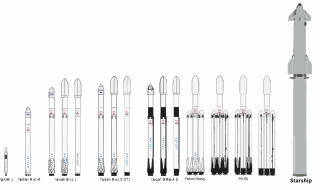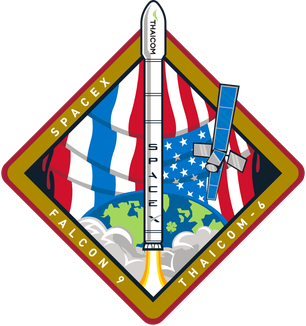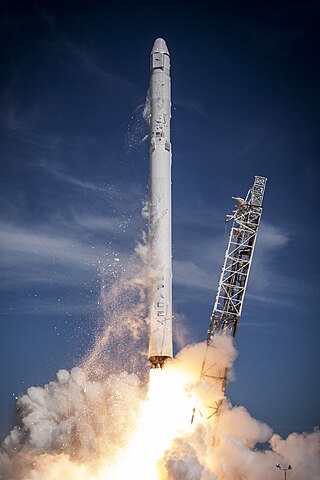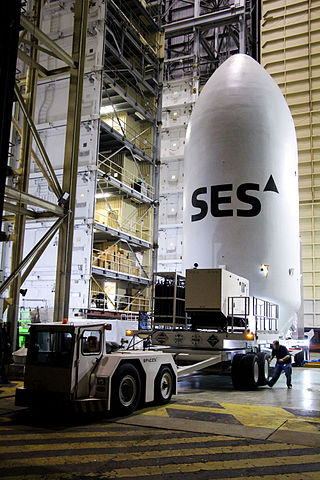
Cascade, Smallsat and Ionospheric Polar Explorer (CASSIOPE), is a Canadian Space Agency (CSA) multi-mission satellite operated by the University of Calgary. The mission development and operations from launch to February 2018 was funded through CSA and the Technology Partnerships Canada program. In February, 2018 CASSIOPE became part of the European Space Agency's Swarm constellation through the Third Party Mission Program, known as Swarm Echo, or Swarm-E. It was launched September 29, 2013, on the first flight of the SpaceX Falcon 9 v1.1 launch vehicle. CASSIOPE is the first Canadian hybrid satellite to carry a dual mission in the fields of telecommunications and scientific research. The main objectives are to gather information to better understand the science of space weather, while verifying high-speed communications concepts through the use of advanced space technologies.

Merlin is a family of rocket engines developed by SpaceX for use on its Falcon 1, Falcon 9 and Falcon Heavy launch vehicles. Merlin engines use RP-1 and liquid oxygen as rocket propellants in a gas-generator power cycle. The Merlin engine was originally designed for sea recovery and reuse, but since 2016 the entire Falcon 9 booster is recovered for reuse by landing vertically on a landing pad using one of its nine Merlin engines.

Falcon 1 was a small-lift launch vehicle that was operated from 2006 to 2009 by SpaceX, an American aerospace manufacturer. On 28 September 2008, Falcon 1 became the first privately developed fully liquid-fueled launch vehicle to go into orbit around the Earth.

Falcon 9 is a partially reusable medium-lift launch vehicle that can carry cargo and crew into Earth orbit, designed, manufactured and launched by American aerospace company SpaceX. It can also be used as an expendable heavy-lift launch vehicle. The first Falcon 9 launch was on 4 June 2010. The first Falcon 9 commercial resupply mission to the International Space Station (ISS) launched on 8 October 2012. In 2020 it became the first commercial rocket to launch humans to orbit and remains the only such vehicle. It is the only U.S. rocket certified for transporting humans to the ISS. In 2022, it became the U.S. rocket with the most launches in history and with the best safety record, having suffered just one flight failure.
Orbcomm is a family of low Earth orbit communications satellites, operated by the United States satellite communications company Orbcomm. As of July 2014, 51 such satellites have orbited Earth, with 50 still continuing to do so.

Falcon Heavy is a partially reusable super heavy-lift launch vehicle that can carry cargo into Earth orbit, and beyond. It is designed, manufactured and launched by American aerospace company SpaceX.

SpaceX manufactures launch vehicles to operate its launch provider services and to execute its various exploration goals. SpaceX currently manufactures and operates the Falcon 9 Block 5 family of medium-lift launch vehicles and the Falcon Heavy family of heavy-lift launch vehicles – both of which are powered by SpaceX Merlin engines and employ VTVL technologies to reuse the first stage. As of 2024, the company is also developing the fully reusable Starship launch system, which will replace the Falcon 9 and Falcon Heavy.

SpaceX has privately funded the development of orbital launch systems that can be reused many times, similar to the reusability of aircraft. SpaceX has developed technologies over the last decade to facilitate full and rapid reuse of space launch vehicles. The project's long-term objectives include returning a launch vehicle first stage to the launch site within minutes and to return a second stage to the launch pad, following orbital realignment with the launch site and atmospheric reentry in up to 24 hours. SpaceX's long term goal would have been reusability of both stages of their orbital launch vehicle, and the first stage would be designed to allow reuse a few hours after return. Development of reusable second stages for Falcon 9 was later abandoned in favor of developing Starship, however, SpaceX developed reusable payload fairings for the Falcon 9.

THAICOM 6 is a Thai satellite of the Thaicom series, operated by Thaicom Public Company Limited, a subsidiary of INTOUCH headquartered in Bangkok, Thailand. THAICOM 6 is colocated with Thaicom 5 at 78.5 degrees East, in geostationary orbit. The total cost for the satellite is US$160 million.

SpaceX CRS-8, also known as SpX-8, was a Commercial Resupply Service mission to the International Space Station (ISS) which was launched on April 8, 2016, at 20:43 UTC. It was the 23rd flight of a Falcon 9 rocket, the tenth flight of a Dragon cargo spacecraft and the eighth operational mission contracted to SpaceX by NASA under the Commercial Resupply Services program. The capsule carried over 3,100 kilograms (6,800 lb) of cargo to the ISS including the Bigelow Expandable Activity Module (BEAM), a prototype inflatable space habitat delivered in the vehicle's trunk, which was attached to the station and, as of May 2022, is expected to remain so for five more full years of in-orbit viability tests.

Falcon 9 v1.1 was the second version of SpaceX's Falcon 9 orbital launch vehicle. The rocket was developed in 2011–2013, made its maiden launch in September 2013, and its final flight in January 2016. The Falcon 9 rocket was fully designed, manufactured, and operated by SpaceX. Following the second Commercial Resupply Services (CRS) launch, the initial version Falcon 9 v1.0 was retired from use and replaced by the v1.1 version.

The Falcon 9 v1.0 was the first member of the Falcon 9 launch vehicle family, designed and manufactured by SpaceX in Hawthorne, California. Development of the medium-lift launcher began in 2005, and it first flew on June 4, 2010. The Falcon 9 v1.0 then launched four Dragon cargo spacecraft: one on an orbital test flight, then one demonstration and two operational resupply missions to the International Space Station under a Commercial Resupply Services contract with NASA.

The Falcon 9 first-stage landing tests were a series of controlled-descent flight tests conducted by SpaceX between 2013 and 2016. Since 2017, the first stage of Falcon 9 missions has been routinely landed if the rocket performance allowed it, and if SpaceX chose to recover the stage.

SES-9 is a geostationary communications satellite operated by SES S.A. It was launched from Cape Canaveral SLC-40 by a Falcon 9 Full Thrust launch vehicle on 4 March 2016.

Falcon 9 flight 20 was a Falcon 9 space launch that occurred on 22 December 2015 at 01:29:00 UTC. It was the first time that the first stage of an orbital rocket made a successful return and vertical landing.

SES-10, is a geostationary communications satellite awarded in February 2014, owned and operated by SES S.A. and designed and manufactured by Airbus Defence and Space on the Eurostar-3000 satellite bus. It is positioned at the 67° West position thanks to an agreement with the Andean Community to use the Simón Bolivar-2 satellite network. It replaces AMC-3 and AMC-4 to provide enhanced coverage and significant capacity expansion.

Falcon 9 Full Thrust is a partially reusable medium-lift launch vehicle, designed and manufactured by SpaceX. It was first designed in 2014–2015, with its first launch operations in December 2015. As of 23 April 2024, Falcon 9 Full Thrust had performed 306 launches without any failures. Based on the Laplace point estimate of reliability, this rocket is the most reliable orbital launch vehicle in operation.

















